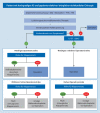[Anesthesia for aortic valve stenosis : Anesthesiological management of patients with aortic valve stenosis during noncardiac surgery]
- PMID: 38334810
- PMCID: PMC10920418
- DOI: 10.1007/s00101-024-01380-x
[Anesthesia for aortic valve stenosis : Anesthesiological management of patients with aortic valve stenosis during noncardiac surgery]
Abstract
Aortic valve stenosis is a common condition that requires an anesthesiologist's in-depth knowledge of the pathophysiology, diagnostics and perioperative features of the disease. A newly diagnosed aortic valve stenosis is often initially identified from the anamnesis (dyspnea, syncope, angina pectoris) or a suspicious auscultation finding during the anesthesiologist's preoperative assessment. Interdisciplinary collaboration is essential to ensure the optimal management of these patients in the perioperative setting. An accurate anamnesis and examination during the preoperative assessment are crucial to select the most suitable anesthetic approach. Additionally, a precise understanding of the hemodynamic peculiarities associated with aortic valve stenosis is necessary. After a short summary of the overall pathophysiology of aortic valve stenosis, this review article focuses on the specific anesthetic considerations, risk factors for complications, and the perioperative management for noncardiac surgery in patients with aortic valve stenosis.
Die Aortenklappenstenose ist eine häufige Erkrankung, die dem behandelnden Anästhesisten profundes Wissen über die Pathophysiologie, Diagnostik und die perioperativen Besonderheiten der Erkrankung abverlangt. Eine neu aufgetretene Aortenklappenstenose wird vielfach erst durch klinische Leitsymptome (Dyspnoe, Synkopen, Angina pectoris) bzw. einen auffälligen Auskultationsbefund im Rahmen der anästhesiologischen Prämedikationsvisite entdeckt und erfordert ein interdisziplinäres Management, um die optimale Behandlung der Patienten im perioperativen Setting zu gewährleisten. Für die individuelle Auswahl des Anästhesieverfahrens ist eine präzise Befunderhebung im Rahmen der Prämedikationsvisite erforderlich, und darüber hinaus eine genaue Kenntnis der hämodynamischen Besonderheiten der Aortenklappenstenose. Der folgende Übersichtsartikel führt nach einer kurzen Rekapitulation der allgemeinen Pathophysiologie der Erkrankung durch die anästhesiologischen Besonderheiten, die Risikofaktoren für Komplikationen und das perioperative Management bei nichtkardiochirurgischen Operationen von Patienten mit Aortenklappenstenose.
Keywords: Echocardiography; Noncardiac surgery; Perioperative management; Risk reduction; Valvular heart disease.
© 2024. The Author(s).
References
-
- Deutsche Gesellschaft für Anästhesiologie und Intensivmedizin (DGAI) SGFaURS, Deutsche Gesellschaft Für Thorax‑, Herz- und Gefäßchirurgie (DGTHG) Neuromonitoring in der Kardioanästhesie. Z Herz- Thorax- Gefäßchir. 2014;28:430–447. doi: 10.1007/s00398-014-1125-4. - DOI
Publication types
MeSH terms
Substances
LinkOut - more resources
Full Text Sources
Medical



